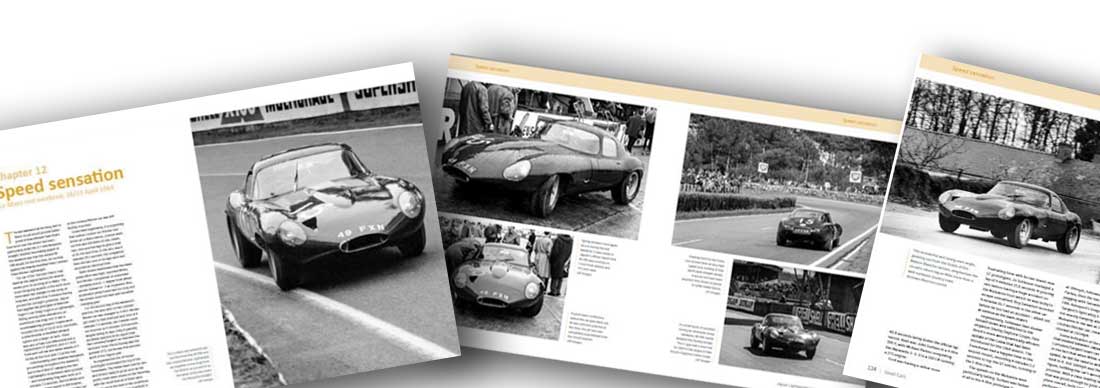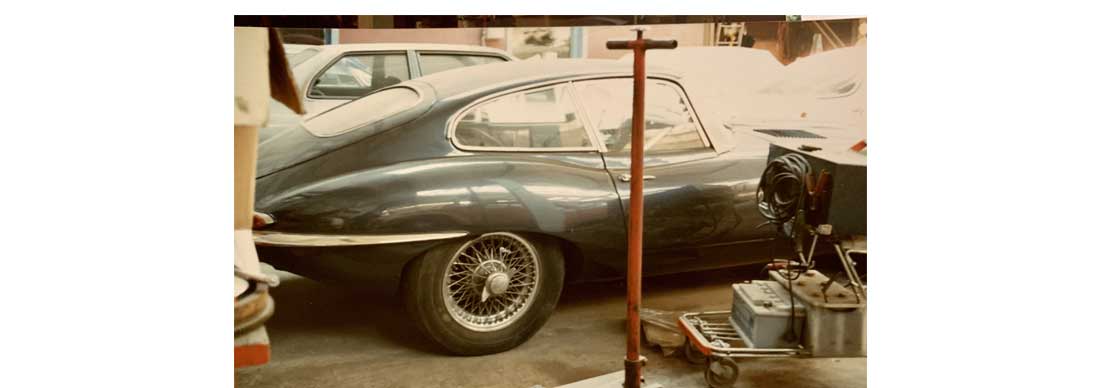
Speed sensation - Le Mans test weekend, 18/19 April 1964
The test weekend at the long, fast Le Mans circuit would provide better proof of how efficient Sami Klat’s hard work over the winter had been – particularly down the 3.7-mile Mulsanne straight. Another fascinating aspect of the weekend was that the revised 49 FXN would, for the first time, be running against the heavily modified Peter Lindner/Peter Nöcker Lightweight.
The car of the ‘German Peters’ had been at the Jaguar factory for several weeks prior to arriving at Le Mans. The most intriguing aspects of the work done there were the changes to the body: at long last, and with Dick Protheroe having proved the concept’s potential, Jaguar had applied the principles of Malcolm Sayer’s Low-Drag Coupé to a Lightweight, fitting, among other alterations, an aluminium low-drag roof. It was a mouthwatering prospect. Engine work included the use of 15/32-inch camshafts, a slide throttle, a modified exhaust system and a larger oil tank. There was also a Powr-Lok differential and a replacement ZF gearbox, plus a 1-inch front anti-roll bar and wider wheels of 7 inches at the front and 7.5 at the rear.
Unfortunately, poor weather hampered proceedings throughout the weekend, but in the 4-litre GT category the two Lightweights nonetheless were quickest – and remarkably they were both on 4 minutes 7.3 seconds. Derrick White sent a post-weekend report to Bill Heynes, and in it he referred to the ‘Lumsden car’ running on cast-magnesium wheels – 7in front, 7.5in rear – as well as having a solidly mounted steering rack. The one on the Lindner/Nöcker car was still flexibly mounted.
Given their experience, it is surprising that neither Lindner nor Nöcker had driven at Le Mans before. Lindner went out first and did stints of one, seven, two, nine and five laps to give a total of 24. His best time, in the rain, was 4 minutes 29.1 seconds. His compatriot then did two runs of six laps each and recorded an identical time.
‘Both drivers mentioned that the brake pedal effort was high,’ reported White, ‘and Nöcker complained of understeer – probably due to –1 degree front wheel camber instead of –2 as requested. Also, accelerator pedal travel was too long and the drivers could not heel and toe when changing gear.’ For the second day of the weekend’s practice, the axle ratio on the Lindner/ Nöcker car was changed to 3.54:1. Nöcker got down to that eventual best time of 4 minutes 7.3 seconds, but Lindner could not improve on 4 minutes 10.4 seconds despite doing 26 laps. Only in passing did White mention in his report that the Lumsden/Sargent car matched the Germans’ time! Pierre Dumay was the quickest GTO, but he was five seconds adrift of the Jaguar pair.
As expected the trio of Ferrari prototypes dominated the top of the timesheets. The Italian team had its cars and drivers ready to go as soon as the public roads were closed on the Saturday, with the result that all of them were able to run in the best of the conditions. Fastest of all was Ludovico Scarfiotti in a 3.3-litre 275 P, his best of 3 minutes 43.8 seconds being inside the official lap record. Next was John Surtees in a 4-litre 330 P, with Michael Parkes completing the Maranello 1–2–3 in a 250 LM running a 275 engine.

Above: The Le Mans test weekend was the first time that 49 FXN and the Lindner/Nöcker Lightweight ran together in low-drag form. The British car proved to be the faster of the two down the Mulsanne straight. LAT Images

Top left image: Spring showers once again struck during the test weekend. It was noted in Jaguar’s official report that 49 FXN was running on 7-inch front wheels and 7½-inch rears. LAT Images
Bottom left: A quick team conference before the car goes back out. As was common practice at the time, the pit lane was completely unprotected from the circuit beyond. LAT Images
Top right: Braking hard for the Esses. Cars arrived here at very high speed and, looking at that earth bank straight ahead, it would not have been anyone’s first choice of places to suffer brake failure. LAT Images
Bottom right: In a brief burst of sunshine during an otherwise damp weekend, 49 FXN rushes beneath the Dunlop bridge. The E-type had a new rival for 1964 in the shape of Pete Brock’s Daytona Cobra Coupe. LAT Images

Above: This wonderful and rarely seen angle, peeking out from the inside of the Maison Blanche section, emphasises the circuit’s return leg as little more than a well-surfaced country road. Archives Maurice Louche
Ford was having a rather more frustrating time with its two brand-new GT prototypes. Jo Schlesser managed a lap of 4 minutes 21.8 seconds in pouring rain before having a huge accident on the Mulsanne from which he was lucky to escape unscathed. Roy Salvadori recorded 4 minutes 35.7 seconds in the other car before he too had an accident – albeit not as serious as his team-mate’s.
Impressively, Schlesser then dusted himself down and switched to the singleton Shelby Daytona Coupe, Pete Brock’s more aerodynamically efficient update of the Cobra that had been introduced for the 1964 season. The Frenchman had a happier time in this second mount, recording 4 minutes 2.3 seconds to top the GT entries, running in the 5-litre class.
The speeds on the Mulsanne were particularly telling. Surtees was fastest of all in the 4-litre prototype Ferrari, at 194mph, followed by Scarfiotti and Parkes, then the two Ford GTs – but levelpegging with Salvadori’s Ford GT was 49 FXN. Autosport’s Gregor Grant reported: ‘Sargent’s light-alloy E-type Jaguar was not exactly hanging about, haring down Mulsanne in the wet at 168mph.’ The Lindner/Nöcker car, meanwhile, was clocked at 161mph.
Some indication of the needle that existed between Jaguar and the Lumsden/Sargent team can be found in the fact that when White noted FXN’s speed, he felt the need to write ‘suspect’ next to it. But 168mph was the official figure, fulfilling the car’s aerodynamic promise. With a class-leading lap time that was good enough for joint sixth place overall, both Lightweights had performed strongly, but it was perhaps the ‘British Peters’ who left La Sarthe walking a little taller.
An extract taken from Jaguar Lightweight E-type - The autobiography of 49 FXN, by Philip Porter & Jame Page





Leave a comment
This site is protected by hCaptcha and the hCaptcha Privacy Policy and Terms of Service apply.